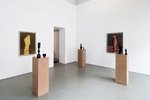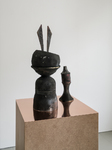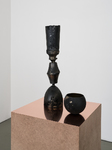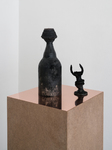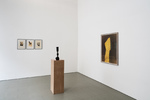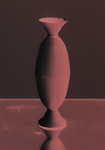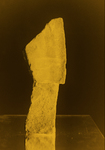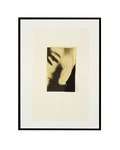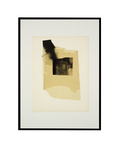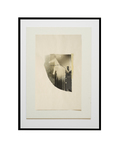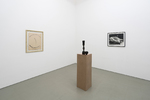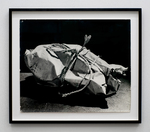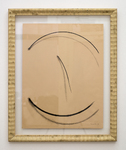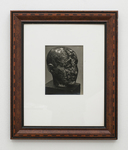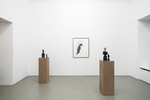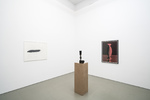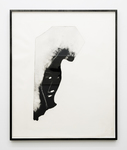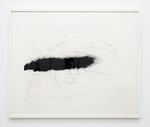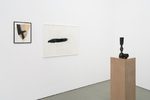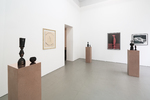... Und sah, daß es gut war ...
Ausgangspunkt seiner Fotoarbeiten sind Fundstücke des Alltags, aus denen er Objekte schafft, die ihm anschließend als Modelle dienen. Dabei interessiert ihn besonders, welche Veränderung diese Dinge in ihren neuen, ihrem zweiten Leben erfahren. So verwandelt sich ein Stapel aus Eierbechern zu einer antik anmutenden, ganz in Rot leuchtenden Vase und ein paar übereinander gestapelte Pflastersteine in eine riesige, gelbe Felswand. Dabei spielt es auch keine Rolle, dass diese Steine in ihrem Vorleben Wurfgeschosse des 1. Mai waren, denn im zweiten Leben spielen Herkunft und politische Überzeugungen keine Rolle mehr. Dieser Bruch oder auch diese Transformation wird sichtbar, indem Henrik Strömberg seine fotografischen Arbeiten ins Negativ übersetzt.
Waren seine Objekte zunächst reine Fotomodelle, so entstanden im Laufe der Zeit emanzipierte Skulpturen,kleinere, geschwärzte Metallskulpturen, die sich in einer Kupferplatte spiegeln. Zusammen mit einem schlanken Sockel aus roher Spanplatte bilden sie eine physische Einheit. Zunächst erinnert das Material der Skulturen an verbrannte Fundstücke zerstörter Häuser, doch Grundlage sind hier gesammelte Pokale. Gefunden auf Flohmärkten werden sie zerlegt, neu zusammengefügt und mit schwarzer Patina versehen. Gab es bei den sonst verwendeten Gebrauchsutensilien die Chance auf ein Leben davor, so sind diese zu Staubfängern erstarrte Erinnerungen, nur reines Material, wie der Lehm aus dem „Prometheus“ seine Kunst geschaffen hat. Henrik hat natürlich Glück, dass in Deutschland für das Erschaffen von Kunst keine, nie endenwollende Qualen zu erwarten sind.
...And he saw, that it was good…
The starting point of his photographic works are found things of the everyday life, from which he creates objects, which later serve as models. He is particularly interested in the changes that these things experience in their new, second life.Thus, a pile of egg cups transforms into an antiquated, vase shining in red light, and a few stacked paving stones into a huge, yellow rock wall. In their transformed existence their past meaning plays no role - the fact that these paving stones where used as “missiles” of the Berlin First of May demonstrators. Their origins and political convictions are now unimportant. This fracture, or even this transformation, becomes visible when Henrik Strömberg translates his photographic work into negative.
If his objects were purely photographic models, over the course of time they became emancipated sculptures : smaller, blackened metal sculptures, which are reflected in a copper plate. Together with a slender base made of raw chipboard they the form a physical unit. At first, the material of the sculptures reminds of burnt small objects, leftovers of destroyed houses, only to later understand that actually the basis is collected trophies. Found on flea markets, they are dissected, reassembled and covered in black patina. If there was before a chance of a life in the used objects, they are now frozen memories; only pure material, bringing about the clay that „Prometheus“ used to create his art. Henrik is, of course, lucky that in Germany no pain is to be expected for the creation of Art.
Patrick Huber
Yes, I am warm now,
but my mind is clear and my vision sharp, as I remember the days without light.
I was preparing for a dinner party, dressed not yet in white. It was almost noon again, I had waited for one hundred days. As the door bell ringed just on time, I knew this was my life.
On the porch of my house I find him today, the priest of my dreams, the father I never had. I kept my linens in my only free hand, and he walked into the room and challenged me to dive into myself.
Many trees have been cut down (I think he was a lumberjack), and many things have been said. Some things have been said many times, and I too am young in life. I may be a child of yours, I may be Gods own, but that nothing springs from nothing, is a truth I know not alone.
I look him in the eyes and I ask “Is this where it is?”, somebody points to me, and says “It’s his”. Across the river I shout “What’s mine?” but I am too late, here it is no longer noon.
At noon Orpheus ferried across the Styx, to a land meant only for the Dead. Me, I am swimming here, but time was not on my side to be had.
The water had risen above my shoulders now, but panic still not on my mind. All the varieties of experience in the world, yet death, this impossible divine. At least Orpheus didn’t have to balance laundry on his head. The Ancient Greeks had style.
I closed the door and went before my mirror again, there I knew where I am. Here I see myself in full portrait, for a hundred days or more. I come back and I come back again too fixate in the glare, every time I see myself I’m not afraid because then I know I’m here.
“Artefacts” was the title of the book, but it was nothing but echoes in the dust. “Artefacts” was the book I read, starting first page as soon as night lost to dusk.
But just like the sun dies away in the end, and leaves all in the dark. We too, must leave a day behind us, leave all artefacts without light.
I, for one, cannot read, but I guess it’s many ways to do. My memories were of course photographs, and in some sense also my idea of unworn white linen, of thyme, of you.
Rasmus Kjelsrud
For the exhibition “echoes in dust” Henrik Strömberg presented an installation of photographic works, collages and sculptures. During the course of the show some of the works were reconfigured, thus altering the overall installation; Keeping the exhibition in a state of flux, selected special works by Man Ray and Jannis Kounellis was interlaced in the installation landscape. The interplay between works of different artistic periods as well as times on a larger scale.
in collaboration with:
Man Ray
(b. 1890 USA – d. 1976 France) was a painter, a photographer and an avant-garde director.
Proponent and representative of Dada movement, he also worked closely to Surrealism.
Man Ray started producing his first ‚rayographs‘ in 1922, special photograms developed with a particular technique: placing actual physical objects onto photosensitized paper, he would later expose to light, thus resulting in a tonal reversal of the objects’ shapes on paper.
Acclaimed with enthusiasm by dadaists, he developed the technique of ‚ready-made’s’: objects belonging to the every day life, decontextualized and deprived of their original use, which become works of art. Influenced by Marcel Duchamp, ambassador of Dadaism, as well as father of the ‚ready-made” concept, Man Ray aimed to promote and develop a substantial change of perspective from the artwork itself to the so called ‚Idea-artwork’. The artist denied the concept of pure and simple visual representation, thus re-evaluating and giving a new signification to the objects.
Loredana Troise for Fondazione Morra
Before leaving Paris for New York in 1921, Man Ray made several constructions that questioned the authority of logic and science over the imagination. This quirky instrument, which he called „Compass,“ was one. The fields of force to which it might respond are as erratic and potentially as destructive as a game of Russian roulette. It is „purely cerebral yet material“ (as Man Ray said of Marcel Duchamp‘s „Large Glass“), whimsical yet deadly earnest.
Metropolitan Museum of Art, New York City
Jannis Kounellis
(b. 1936 Greece - d. 2017 Italy) was the pioneer and one of the most important representatives of the artistic movement Arte Povera.
As a student in Rome, Kounellis’s appreciation of his cultural roots did not isolate him from more contemporary influences. He was profoundly affected by the most avant-garde Italian art, ranging from Alberto Burri’s stitched scraps of sacks to Piero Manzoni’s “achromes”. Along with artists like Joseph Beuys, Mario Merz, Robert Morris and Richard Serra, he is part of a second wave of modernists who, in the 60s, radically expanded our vision of fine art with a new iconography of materials. Kounellis‘ work is comprised of painting, collage, sculpture, installation work, performance and theatrical shows. Starting as a painter, he produced series of audacious paintings entitled Alphabets, in which he stenciled letters, numerals, and even traffic markings – the most impersonal, universal signs – onto otherwise abstract canvases. In 1960s Kounellis introduced the use of everyday material to his work - such as wool, coal, iron, stones, earth, wood and objets trouvés, as well as animals to create sculptures and installations.
“I have only ever sought beauty. I measured distance through objectivity. I saw the sanctity of
everyday objects.”
Jannis Kounellis
The use of antithetical media, such as raw material and objets trouvés, expresses the tension and alienation of our contemporary society. The artist used the objects placing them in often startling juxtapositions, re-evaluating them by creating a new poetic context in which they represented the pivotal body of a new aesthetic outcome.
„I desperately seek unity, albeit difficult to attain, albeit utopian, albeit impossible and therefore dramatic.“
Jannis Kounellis
Henrik Strömberg - echoes in dust.pdf
PDF-Dokument [32.6 MB]

